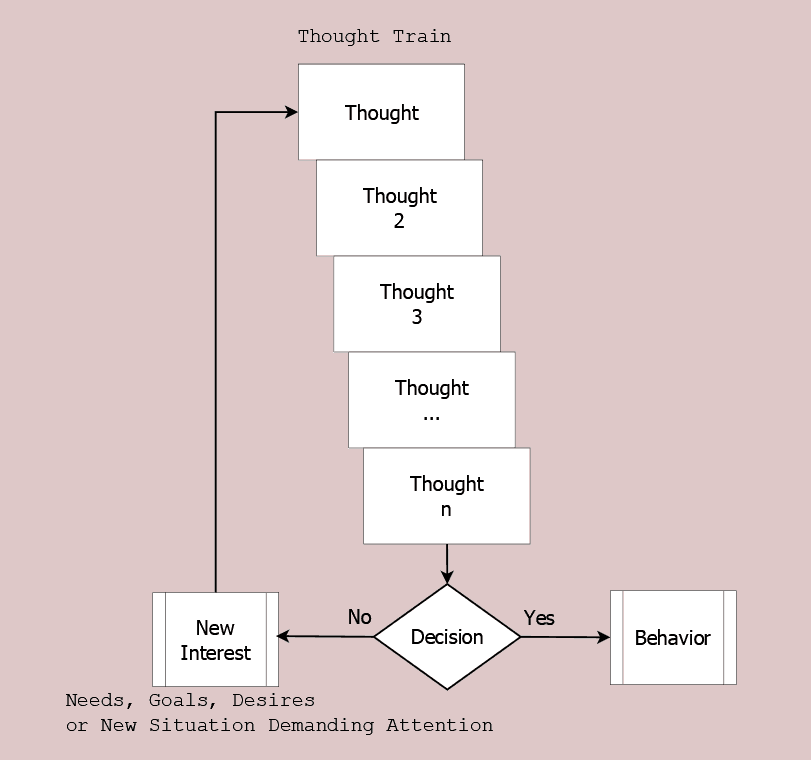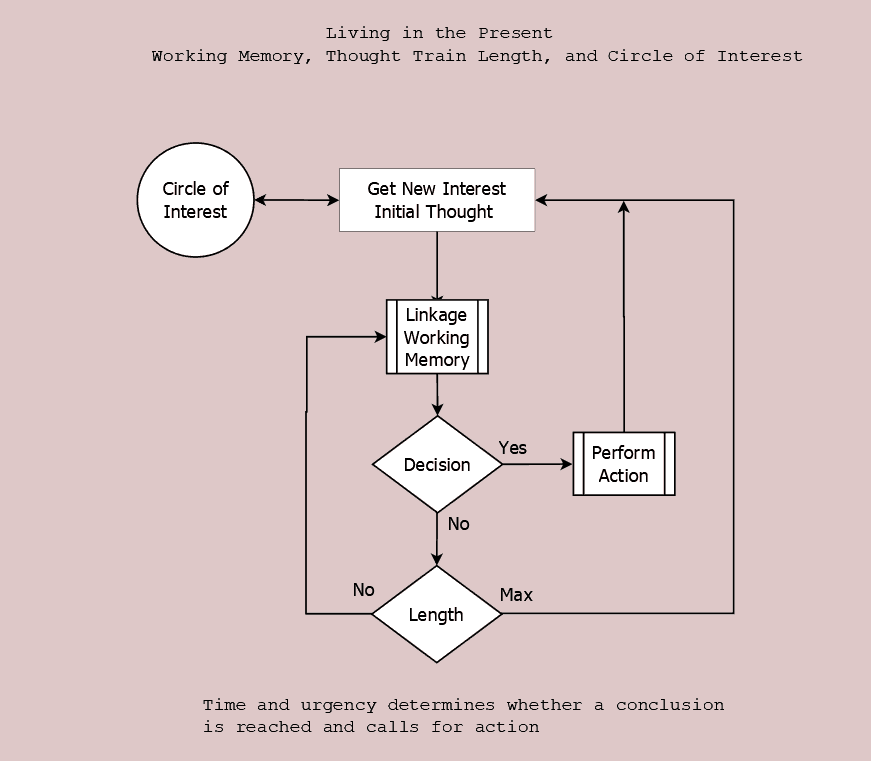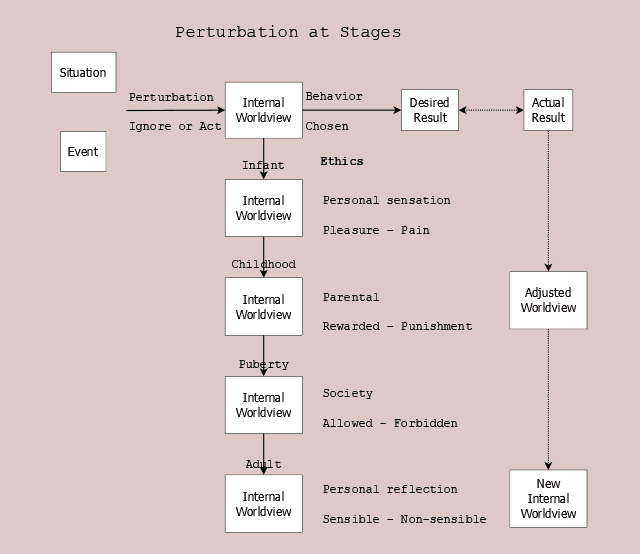Everyone has a length their thoughts can extend to, when they consider an idea and when they are uninterrupted. That length is is unique for each person and fairly stable. That’s the thought train length.
If it offends your sense to consider thoughts as discrete (William James discusses both sides in the chapter “The Stream of Thought” p 146-287), let me suggest that you might consider this measure as duration rather than length. The logic of the progress from incipient thought to the terminating thought is analogous.That is, a person thinks into a subject to the limit of their thought train length. If they arrive at a decision, they perform it. If they don’t before their thought train length is exhausted, they give up on that topic and start on a topic anew.

In the thought train diagram, I’ve focused on the path, the length and the final decision. Although I’ve used the word “decision,” the thought train is typically pre-conscious thoughts. The manner by which thought trains become available to our verbal analysis occurs most readily when we seek out a non-interruption and extend our effective thought train length by inventions such as pen and paper and computers to store our intermediate results.
Meditation, isolation, and quiet story are means we consciously use to extend this predominantly pre-conscious mechanism.
Logical or Similarity
The manner in which the thought train is linked varies among people. Most people have a dominant style.
- Some people are heavily logical. Their ideas are predominantly logical linked.
- Others, like me, often follow a thread of similarity. If several features are the same, then the next thought may occur even though it’s not logically linked.
Not Probabilistic Logic, but Treating Likelihoods as Certainties
In casual terms, some might label similarity as probabilistic logic. The distinction is that similarity does not precede according to logical rules. Instead, a similarity is treated as a fact (pounding into an actuality). Then, often without conscious direction, one sees where the fact leads logically. Fuzzy logic or probabilistic joining of propositions are not performed. The logical operations are performed as in normal logic. There is no special A union B probabilistic operation. It is take an A that is possible and act as if it’s a certainty.
People use both methods. Those that are mostly logically fixed on their basic premises earlier in life– because their neurobiology found many patterns which they could work to success early in life. These people less frequently alter their propositions later in life. Primarily because they have a high threshold to match.
Others have more fluid propositional assignments as adults. Although it may seem counter-intuitive, these people (with lower Almost Gates to accept matches) use fewer feature matches for an assignment. Thus, in their formative years, often too many possibilities existed to pick single concepts to express their internal reality.
Finite Brain

The Finite Brain flowchart gives the essential components of thought train operation.
- We have a relatively small set of interests which we analyze the environment for ways to satisfy our needs, desires, and goals.
- Working memory limits the length of the train of thoughts we develop to a starting interest in conjunction with the current situation.
- If we see a decision that satisfies our particular current interest, we take the action. We perform the behavior (which can include speaking).
- If we don’t see a decision, we think further, look for related thoughts.
- This continues until either we make a decision or we exhaust our working memory.
- A new topic of interest starts the same sequence at the top of the thought train.
Interruption of Thought Train
In the earliest days of human development, the entire thought train was often not completed–because of peril from predators and from starvation. As we mastered our environment, those peril became less omnipresent. Our working memory could be exhausted before interruption.
Experience and Experiment
Psychologists have warned about the dangers of using introspection as a method to understanding the brain’s operations. And yet four hundred years ago Descartes pointed out that our thinking is the only thing we can be sure of. Upshot: introspection can be used for idea generation, with the caveat that it can be wrong and must be tested.
One late night I awoke and was unable to return to sleep. At loose ends, I played Spider Solitaire for a couple of hours until exhaustion. In my dreams, people were compared by relative heights, in a manner not unlike the pair-wise comparison for card value in solitaire. Later when I awoke and next watched TV, I noticed that I was considering the story characters’ relative statures. It was transient effect. When I rejected that line of thought as unproductive, surprisingly the consideration reoccurred without my volition.
That occurrence–the persistence of an algorithmic process beyond its utility–lasted a day and a half. Having sleep apnea and a slowly, dawning realization of the linkage between hours on solitaire and the hangover of its processing, I experienced this a number of times before I banned Spider Solitaire from my activities.
Sudoku is another game that leaves a thought train cycle ready to be reactivated in real life if I’ve over-played the game. For me, four games in a row moves me into the mode. Here, the comparison of items in my external reality with the idea they can slide along a tic-tac-toe board is not so distressing, until I try to go to sleep. Deprived of competing external input, my mind replays fractional sequences of Sudoku interring with my normal glide path to sleep.
You might want to try overdosing on Spider Solitaire or Sudoku once, to experience the thought train working on inappropriate material.
Thought trains, in these cases, are algorithms that persist and take time to breakdown. Eventually their neural traces will be replaced by new thought trains, customized for new changes to your external reality.
These two cases are anomalies because extreme repetition causes Hebb’s Law to make their thought trains unusually strong and lasting.When an axon of cell A is near enough to excite B and repeatedly or persistently takes part in firing it, some growth process or metabolic change takes place in one or both cells such that A’s efficiency, as one of the cells firing B, is increased.
Hebb’s Law that tells us that the neural path strengthens by repeated use. In these examples, it causes the thought train to last beyond its useful lifetime.
Multiple Thought Trains
We have multiple thought trains. Grossly, two thought trains for each interest we have.
Thought trains exist as two basic kinds.
- Content. A set of thoughts linked by previous rumination in the subject area. The set remains in long-term memory ready to be used by working memory when needed. All college introductory courses are basically learn the vocabulary of the subject and the theory connecting them together. Concern about exceptions, special rules and constraints are ignored to get the student started.
- On a more fundamental basis that’s what we all do with our interest areas. Discovering the basic ideas and relationships between our needs, desires, goals, and situations occurs at different paces according to a person’s genetic endowment and their personal experience.
- Operational. A common sequence of processing for the topic. This thought train processes a current situation against the internal worldview (in long-term memory) in a order that has been successful in the past..
Nature, Perturbation, Internal Worldview, and Thought Trains

It’s important to understand that we treat and react to reality as perturbations to our internal worldview rather each instant being a separate reality to react to. External reality is understood within the framework that we have developed. A change occurs in external reality. We organize the event or situation according to concepts in our existing worldview. As the figure shows, our internal worldview only alters when the actual result of the behavior differs significantly from our desired result.
Internal worldview changes slowly in most cases. The magnitude of change due to each current situation is minuscule compared to vast internal conceptions we entered the situation with. The Development of the Adult Mind has more information about the forces that impel changes in our progress from infant to adult.
Thought trains, sequences of thoughts, are crucial features in how we determine mentally handle our changing environment in satisfying our needs, our desires, and our goals. We think in relatively short chains of thoughts, some connected by logic and some connected by similarity.
Also see Mindsets: Stimuli to Concepts The internal worldview in which thought trains travel